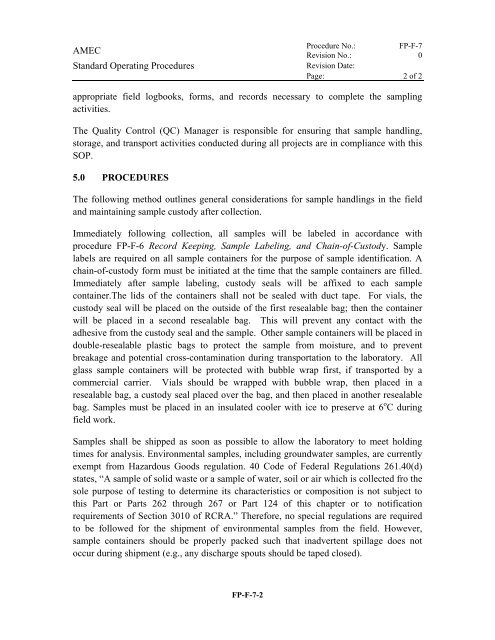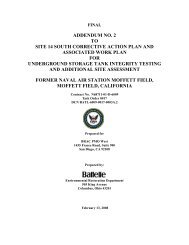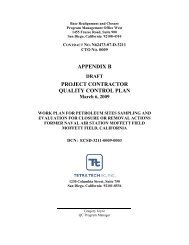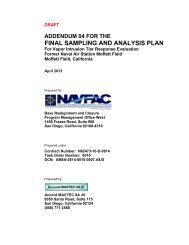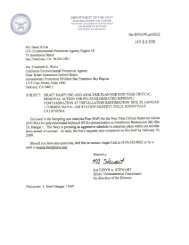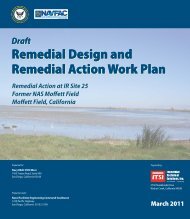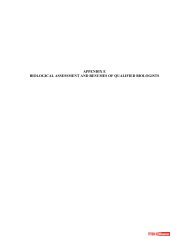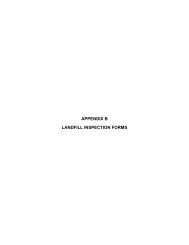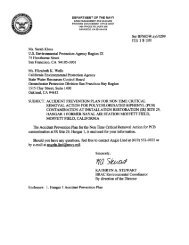FINAL SAMPLING AND ANALYSIS PLAN - Documents for Moffett Field
FINAL SAMPLING AND ANALYSIS PLAN - Documents for Moffett Field
FINAL SAMPLING AND ANALYSIS PLAN - Documents for Moffett Field
You also want an ePaper? Increase the reach of your titles
YUMPU automatically turns print PDFs into web optimized ePapers that Google loves.
AMEC<br />
Standard Operating Procedures<br />
Procedure No.:<br />
FP-F-7<br />
Revision No.: 0<br />
Revision Date:<br />
Page: 2 of 2<br />
appropriate field logbooks, <strong>for</strong>ms, and records necessary to complete the sampling<br />
activities.<br />
The Quality Control (QC) Manager is responsible <strong>for</strong> ensuring that sample handling,<br />
storage, and transport activities conducted during all projects are in compliance with this<br />
SOP.<br />
5.0<br />
PROCEDURES<br />
The following method outlines general considerations <strong>for</strong> sample handlings in the field<br />
and maintaining sample custody after collection.<br />
Immediately following collection, all samples will be labeled in accordance with<br />
procedure FP-F-6 Record Keeping, Sample Labeling, and Chain-of-Custody. Sample<br />
labels are required on all sample containers <strong>for</strong> the purpose of sample identification. A<br />
chain-of-custody <strong>for</strong>m must be initiated at the time that the sample containers are filled.<br />
Immediately after sample labeling, custody seals will be affixed to each sample<br />
container.The lids of the containers shall not be sealed with duct tape. For vials, the<br />
custody seal will be placed on the outside of the first resealable bag; then the container<br />
will be placed in a second resealable bag. This will prevent any contact with the<br />
adhesive from the custody seal and the sample. Other sample containers will be placed in<br />
double-resealable plastic bags to protect the sample from moisture, and to prevent<br />
breakage and potential cross-contamination during transportation to the laboratory. All<br />
glass sample containers will be protected with bubble wrap first, if transported by a<br />
commercial carrier. Vials should be wrapped with bubble wrap, then placed in a<br />
resealable bag, a custody seal placed over the bag, and then placed in another resealable<br />
bag. Samples must be placed in an insulated cooler with ice to preserve at 6 o C during<br />
field work.<br />
Samples shall be shipped as soon as possible to allow the laboratory to meet holding<br />
times <strong>for</strong> analysis. Environmental samples, including groundwater samples, are currently<br />
exempt from Hazardous Goods regulation. 40 Code of Federal Regulations 261.40(d)<br />
states, “A sample of solid waste or a sample of water, soil or air which is collected fro the<br />
sole purpose of testing to determine its characteristics or composition is not subject to<br />
this Part or Parts 262 through 267 or Part 124 of this chapter or to notification<br />
requirements of Section 3010 of RCRA.” There<strong>for</strong>e, no special regulations are required<br />
to be followed <strong>for</strong> the shipment of environmental samples from the field. However,<br />
sample containers should be properly packed such that inadvertent spillage does not<br />
occur during shipment (e.g., any discharge spouts should be taped closed).<br />
FP-F-7-2


